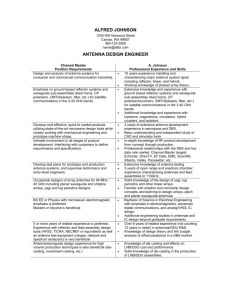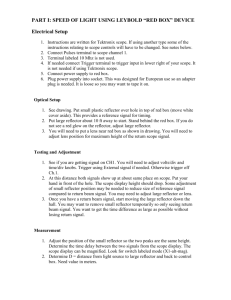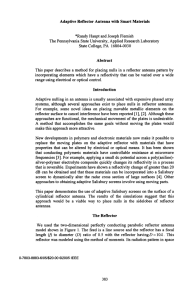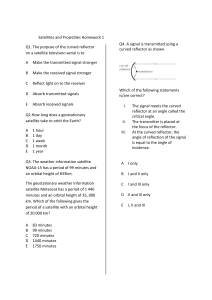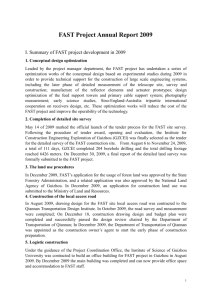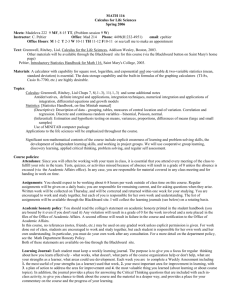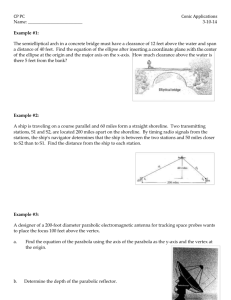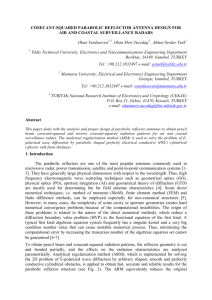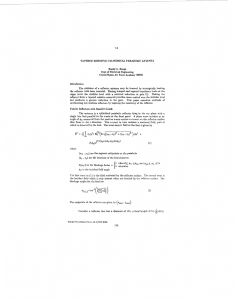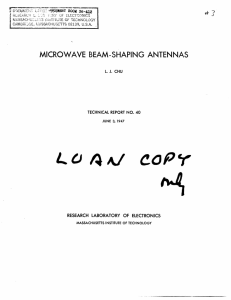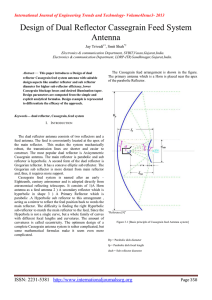On the Design of Reflector Antennas for Cosecant Squared Power
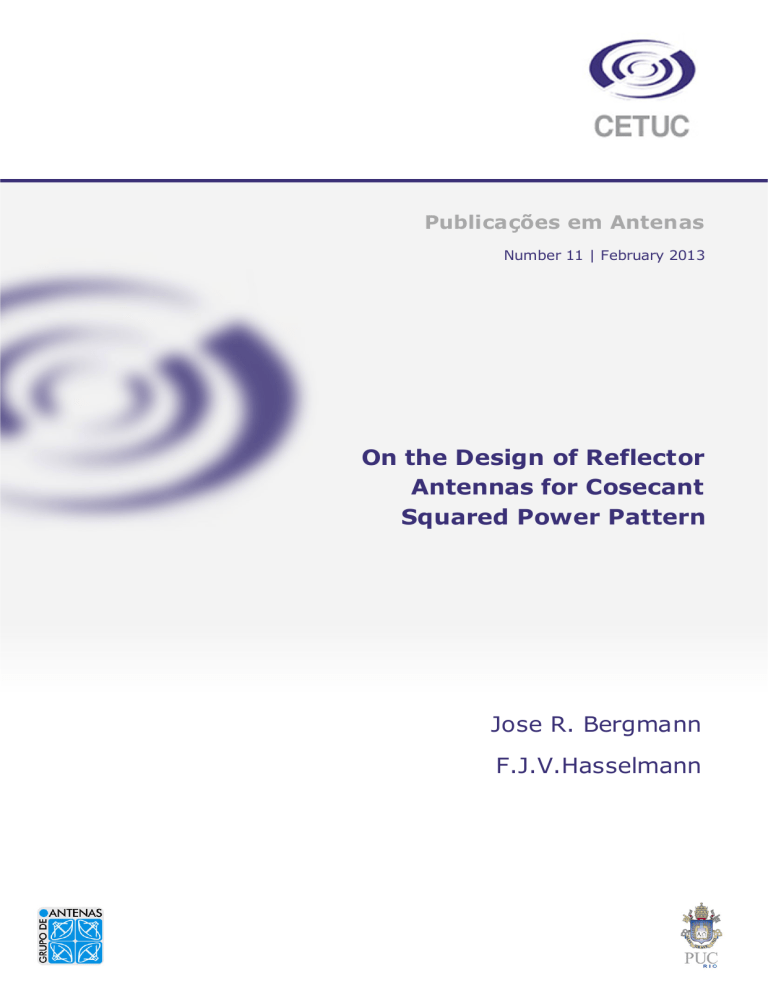
Publicações em Antenas
Number 11 | February 2013
On the Design of Reflector
Antennas for Cosecant
Squared Power Pattern
Jose R. Bergmann
F.J.V.Hasselmann
Publicações em Antenas
Number 11 | February 2013
On the Design of Reflector
Antennas for Cosecant
Squared Power Pattern
Jose R. Bergmann
F.J.V.Hasselmann
CRÉDITOS
Publisher:
MAXWELL / LAMB DA-DEE
Sistema Maxwell / Laboratório de Automação de Museus, Bibliotecas Digitais e Arquiv os http://www.maxwell.lambda.ele.puc-rio.br/
Editor:
Jose Ricardo Bergmann
Capa:
Ana C ris tina Cos ta Ribeiro
© 2000 IEEE. Reprinted, with permission, from IEEE ANTENNAS AND PROPAGATION
SOCIETY INTERNATIONAL SYMPOSIUM, VOL. 4, 2000. This material is posted here with permission of the IEEE. Such permission of the IEEE does not in any way imply IEEE endorsement of any of Pontifícia Universidade Catolica do Rio de Janeiro’s. Internal or personal use of this material is permitted. However, permission to reprint/republish this material for advertising or promotional purposes or for creating new collective works for resale or redistribution must be obtained from the IEEE by writing to pubspermissions@ieee.org
. By choosing to view this document, you agree to all provisions of the copyright laws protecting it.
ON THE DESIGN OF REFLECTOR ANTENNAS FOR COSECANT
SQUARED POWER PATTERN
J.R. Bergmann and F.J.V.Hasselmann
CETUC-Center for Telecommunications Studies of the Catholic University,
Rio de Janeiro, RJ 22453-900, B r a d
INTRODUCTION
The characteristics of a reflector antenna radiating omnidirectionally in azimuth with a cosecant-squared power pattem in vertical planes, as intended for point-to- multipoint services in the millimetric wave range and comprising a single circularly symmetrical shaped reflector surface fed by an axial horn, were presented in [I], as an altemative to configurations reported elsewhere, involving nodal stations with up to four antennas for quadrant sectors coverage [2] or dual reflector arrangements for omnidirectional coverage [3]. Reported results, considering a rigorous feed model for the constructed prototype, then highlighted the main features of the proposed design. The present work extends the previous investigation by considering the effect of employing larger feed apertures yielding more collimated primary fields, with a view towards synthesizing more compact reflector surfaces.
ANTENNA DESIGN AND RESULTS
The antenna design explored herein comprises a single conically shaped reflector surface of revolution fed by an axial horn placed below the reflector and pointing towards the zenith, thus resulting in a horizontal reflector with spillover energy directed above the horizon line. The reflector surface generatrix is first synthesized according to Geometrical Optics (GO) postulates for a cosecant squared secondary antenna pattern in the vertical plane, so as to account for free- space attenuation between base station and receiver ends, while concentrating energy below the horizon line for reduced interference. The resulting surface is then used as an initial solution to the more comprehensive Physical Optics synthesis, involving the minimization of an objective b c t i o n descriptive of the difference between PO-obtained and specified cosecant-squared power patterns in the main coverage region. As stated above, a larger feed aperture was employed so as to radiate a narrower primary lobe onto the reflector, allowing the use of a
more compact reflector surface. Fig. 1 compares the feed pattern of the present
configuration and that previously investigated [ 11, revealing that larger edge illumination levels may now be responsible for otherwise reduced diffraction as well as spillover effects. Nevertheless, a reflector diameter reduction (of almost
50%) to 20h was now possible as revealed in Fig. 2 where both previous and
present geometries and corresponding ray structures are illustrated. The resulting antenna radiation pattern shows, in comparison to the previous one as depicted in
Fig. 3, not only a enhanced spillover sidelobe distribution above the horizon line
1930
but also a more explicit interference (diffraction caused) pattem in the main coverage region, as introduced by feed bak-scattering effects and higher edge diffraction on the reflector itself. As in the previous study, the interference caused by feed back-scattered energy may be alleviated by placing a corrugated flange in the feed aperture; optimized feed designs and corresponding effects are presently under consideration.
REFERENCES
[I] J.R. Bergmann, F.J.V. Hasselmann and M.G.C. Branco, “A shaped reflector antenna for mobile communications”, IEEE AP-S Int. Symp. Digest, 1999.
[2] J.R. Bergmann and F.J.V. Hasselmann, “Considerations on the design and analysis of a shaped reflector antenna for nodal stations in metropolitan areas”,
Proc. gth IEE Int. Conf. Antennas Propagat., vol. 1, pp. 195-198, 1995.
[3] M. Orefice and P. Pirinoli, “A dual reflector antenna for omnidirectional coverage”, IEEE AP-S Int. Symp. Digest, pp. 274-277, 1993.
ACKNOWLEDGEMENT
This work was supported by Financiadora de Estudos e Projetos under Covenant
FINEP 41.96.0901 .OO-PRONEX.
12
---
- t
\
\
-9
-
0 10 20 30 40 50 60
Fig 1
-
Feed primary patterns
1931
70 80 0
0 5 10
P
(a)
15 20 25
12
10
8
6
4
2
& i o
U
-2
-4
-6
-8
-10
-30 -15 0 15 30 45 60 75 90
Figure 2
-
Antenna geometry and pattern for original design
1932
12
10
8
6
4
Y
N 2
0
-2
-4
0 2 4 6 8 I O 12 14 16 18 20 22 24
P
(4
12
9
6
3
- - - cosec2a
U
-3
-6
-9
-30 -15 0 15 30 degrees
45 60 75
Figure 3
-
Antenna geometry and pattern for present design
90
1933
